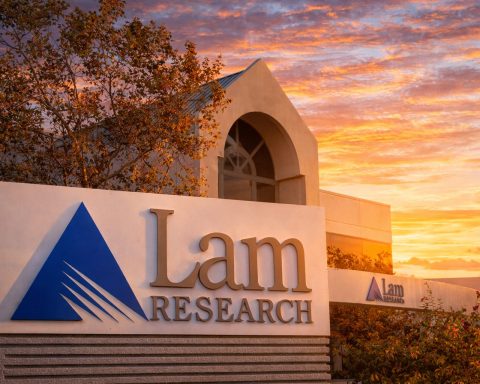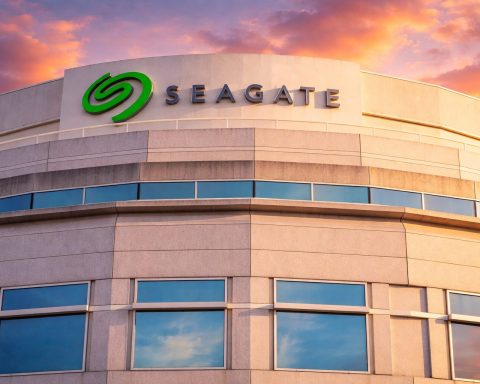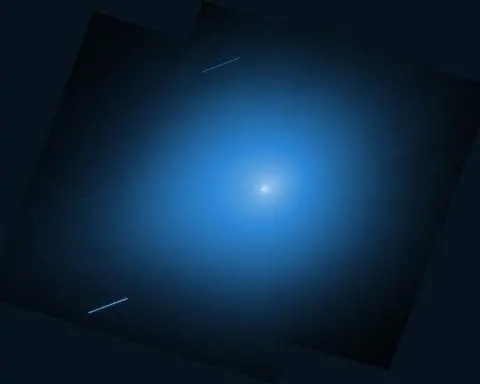- Themis arrives at Esrange Space Center in Sweden, Europe’s first full-scale reusable rocket stage demonstrator by ArianeGroup for ESA’s reusability roadmap, after a 3,000-kilometer journey and hop-tests expected to begin in late 2025 under the EU SALTO project.
- 3I/ATLAS (C/2025 N1), the third known interstellar object to visit our solar system, is traveling at about 60 km/s with cometary activity and will be visible until September 2025.
- MethaneSAT, a $100 million climate mission launched in March 2024 to map global methane emissions, has suffered a power failure and is likely not recoverable, a major setback for climate monitoring.
- The UK Space Agency has launched a £75.6 million procurement for an active debris removal mission to clear two defunct satellites from low Earth orbit by 2028, signaling a push for orbital sustainability.
- The James Webb Space Telescope has delivered the most detailed map of dark matter in the Bullet Cluster via gravitational lensing, based on the largest lensing dataset to date.
- NASA’s Mars Reconnaissance Orbiter has begun 120-degree rolls to enhance SHARAD radar imaging of Mars’ subsurface after nearly 20 years in space.
- MTG-S1, Europe’s first geostationary weather sounding satellite, was launched to provide high-frequency atmospheric data and carries Copernicus Sentinel-4 to improve weather forecasts and greenhouse gas tracking.
- CBERS-5 will be Brazil and China’s geostationary meteorological satellite, marking Brazil’s first geostationary satellite and boosting data sovereignty and disaster response capabilities.
- Boeing won a $2.8 billion Space Force contract to develop two Evolved Strategic Satellite Communications satellites, with the first launch expected by 2031 and enhanced security and global coverage.
- Congress approved a $10 billion boost for NASA’s Artemis lunar program, funding additional SLS rockets and Gateway despite opposition from SpaceX, signaling continued federal investment in crewed lunar exploration.
This Week in Space: Reusable Rockets, Interstellar Visitors, and the Future of Earth Observation
The past week has seen a torrent of developments across the space sector, from Europe’s push toward reusable launchers and the detection of a new interstellar object, to the sobering loss of a major climate-monitoring satellite. As the world’s eyes turn skyward, the interplay of innovation, geopolitics, and environmental stewardship is more evident than ever. Here’s an exhaustive look at the latest headlines shaping the future of space.
Europe’s Leap Toward Reusable Rockets: Themis Arrives at Esrange
Europe has long trailed the United States and China in the race for reusable launch vehicles, but the arrival of the Themis demonstrator at Sweden’s Esrange Space Center marks a pivotal milestone. Developed by ArianeGroup under the European Space Agency’s (ESA) reusability roadmap, Themis is Europe’s first full-scale reusable rocket stage demonstrator. Its journey—spanning 3,000 kilometers—culminates in a series of integration and hop-tests, supported by the EU’s SALTO project.“The arrival of the Themis at Esrange marks an important milestone for this project.”
— Ulrika Unell, SSC
What’s Next for Themis?
- Integration and Wet Dress Rehearsal: The stage will be assembled and undergo full systems checks.
- Hop Tests: Scheduled to begin in late 2025, these short vertical flights will validate landing, guidance, and reusability technologies.
- Strategic Impact: Themis is a critical step for Europe to compete in the global launch market, reduce costs, and foster technological sovereignty.
The Interstellar Frontier: 3I/ATLAS and the Search for Planet Nine
3I/ATLAS: A New Interstellar Visitor
Astronomers have confirmed the detection of 3I/ATLAS (C/2025 N1), only the third known interstellar object to pass through our solar system. Traveling at a blistering 60 km/s and exhibiting cometary activity, 3I/ATLAS is a rare opportunity to study material from beyond our Sun’s domain.“If confirmed, it will be the third known interstellar object… providing more evidence that such interstellar wanderers are relatively common in our galaxy.”
— Dr. Mark Norris
- Trajectory: Its hyperbolic path confirms an origin outside the solar system.
- Observability: It will be visible until September 2025 before passing behind the Sun.
- Scientific Value: Offers direct insight into the composition and behavior of extrasolar material.
The Elusive Planet Nine
In parallel, astronomers analyzing data from the IRAS and AKARI satellites have identified a possible candidate for the long-hypothesized Planet Nine beyond Neptune. While skepticism remains due to the object’s unusual orbit, the upcoming Vera C. Rubin Observatory may soon provide definitive evidence.- Potential Impact: Confirmation would reshape our understanding of the solar system’s architecture.
- Skepticism: The orbit and characteristics remain contentious among planetary scientists.
MethaneSAT: A Climate Monitoring Setback
The Loss of a Pioneering Satellite
The MethaneSAT satellite, a $100 million mission launched in March 2024 to track global methane emissions, has suffered a catastrophic power failure and is “likely not recoverable.” Funded by the Environmental Defense Fund (EDF), Bezos Earth Fund, and Google, MethaneSAT filled a unique observational niche, providing advanced spectrometer data on greenhouse gas emissions.“The satellite has lost power, and it is likely not recoverable.”
— Environmental Defense Fund
- Mission Achievements: Demonstrated direct, high-resolution methane measurement from space; revealed unexpectedly high emissions from oil and gas sites.
- Setback: The loss is significant for climate transparency and monitoring, as MethaneSAT’s data was crucial for policy and mitigation efforts.
- Next Steps: EDF is considering a replacement satellite, and all data collected to date will be processed and released.
Satellite Technology: Progress, Peril, and Policy
The UK’s Bold Step in Space Debris Removal
The UK Space Agency has launched a £75.6 million procurement for its first active debris removal mission, aiming to clear two defunct satellites from low Earth orbit by 2028. This initiative positions the UK at the forefront of the in-orbit services market and addresses the growing threat of space debris to operational satellites.Read more: [16], [17], [18]“It’s about securing the future of space for everyone… and positioning the UK at the forefront of the in-orbit services market.”
— Dr Paul Bate, UKSA CEO
Starlink’s Solar Storm Setback
SpaceX’s Starlink constellation has lost 583 satellites between 2020 and 2024, primarily due to increased solar activity. Solar storms heat Earth’s upper atmosphere, increasing drag and causing satellites to deorbit faster—a stark reminder of the vulnerability of mega-constellations to space weather.Read more: [19]“This increased drag can cause satellites to burn up prematurely.”
— Yang Yuguang
The Rise of Satellite IoT and Telecom
- Open Cosmos has acquired Portuguese startup Connected to accelerate affordable, standardized satellite IoT services in Europe, with ESA support.
- Amazon will launch satellite telecom services in Europe via Project Kuiper, aiming to compete with Starlink and provide internet access in underserved areas.
- Türkiye and Azerbaijan have integrated satellite-based IoT networks, enhancing rural connectivity and supporting digitalization in key sectors.
International Partnerships and Geopolitics
Brazil and China: CBERS-5 Geostationary Satellite
Brazil and China have finalized an agreement to jointly develop CBERS-5, their first geostationary satellite for meteorological and environmental monitoring. This marks a major technological leap for Brazil, providing data sovereignty and enhancing disaster response capabilities. The project underscores the importance of international collaboration and technology transfer in space.Read more: [23], [24], [25], [26], [27]“Esse será o primeiro satélite geoestacionário desenvolvido pelo Brasil… representa um enorme salto tecnológico.”
— Minister Luciana Santos
US-China Fusion Race
A US satellite has revealed China’s colossal, star-shaped nuclear fusion facility in Mianyang, Sichuan, visible from space and at least 50% larger than the US National Ignition Facility. While promising for clean energy, the facility also raises military and geopolitical concerns.Read more: [28], [29]“This breakthrough could reshape global power dynamics, offering clean energy but raising security concerns due to its potential military applications.”
— William Alberque
Russian Military Satellites and Space Security
- A Russian military satellite is currently out of control, raising concerns about space debris and the safety of other satellites.
- Russia’s ‘Matryoshka’ satellites, capable of deploying stealthy, potentially weaponized mini-satellites, have intensified US concerns over space stalking and anti-satellite warfare.
Science Highlights: Webb’s Dark Matter Maps, Mars Missions, and More
James Webb Space Telescope: Dark Matter and Exoplanets
The James Webb Space Telescope (JWST) has delivered the most detailed map of dark matter in the Bullet Cluster, using gravitational lensing to reveal new insights into its distribution during galactic collisions.“We carefully measured the mass…with the largest lensing dataset to date.”
— Sangjun Cha
- Direct Imaging: Webb has also used its coronagraph to directly image a possible exoplanet, TWA 7 b, orbiting a red dwarf 111 light years away.
- Impact: These breakthroughs refine our understanding of cosmic structure and planetary formation.
Mars Reconnaissance Orbiter: New Tricks After 20 Years
NASA’s Mars Reconnaissance Orbiter (MRO), after nearly two decades in space, is now performing complex 120-degree rolls to enhance its SHARAD radar’s ability to probe beneath Mars’ surface. This enables clearer imaging of underground ice and rock, aiding future exploration and the search for water.Read more: [35], [36], [37]“Not only can you teach an old spacecraft new tricks…”
— Gareth Morgan
Atmospheric and Weather Science
- MTG-S1, Europe’s first geostationary weather sounding satellite, was launched to deliver high-frequency atmospheric data, improving weather forecasts and early warnings.
- OceanSODA-ETHZ and similar advanced satellite technology now provide high-resolution, frequent data on ocean carbon absorption, crucial for understanding the global carbon cycle.
Space Policy, Defense, and Commercialization
US Space Force and Boeing: Next-Gen SATCOM
The US Space Force has awarded Boeing a $2.8 billion contract for the Evolved Strategic SATCOM (ESS) program, funding two secure satellites to enhance national defense communications. These will replace the AEHF constellation, offering improved survivability, resilience, and cybersecurity.Read more: [41], [42], [43]“Unmatched reliability for evolving security needs.”
— Kay Sears, Boeing VP
Space Infrastructure and Environmental Concerns
- The US Air Force has halted plans for rocket landing pads on Johnston Atoll due to environmental backlash, highlighting the growing scrutiny of space infrastructure in sensitive ecosystems.
- The Trump administration plans to terminate three critical DMSP weather satellites before peak hurricane season, raising concerns about forecast accuracy and public safety.
Commercial Space and Legislative Influence
- Elon Musk’s influence in Texas has grown, with new laws protecting SpaceX operations and facilitating rocket launches, sparking debate over corporate power and regulatory oversight.
- The US Congress has approved a $10 billion boost for NASA’s Artemis lunar program, favoring traditional contractors over reusable rockets, despite opposition from SpaceX.
Space Science: From the ISS to the Edge of the Solar System
ISS: Science, Sprites, and Space Cuisine
- The Ax-4 crew aboard the ISS has advanced research in cancer, muscle atrophy, microalgae, crop growth, eye-tracking, and radiation monitoring, supporting future exploration and benefiting life on Earth.
- ESA astronaut Sophie Adenot will bring gourmet dishes by Michelin-starred chef Anne-Sophie Pic to the ISS, blending culinary excellence with space nutrition.
- Astronaut Nichole Ayers captured rare sprite phenomena—giant, colorful electrical discharges in the upper atmosphere—offering unprecedented insight into Earth’s electric skies.
Mars: New Images and Construction Materials
- ESA’s Mars Express has captured stunning multicolored images of Arcadia Planitia, revealing the Red Planet’s diverse geology.
- Scientists have demonstrated that ceramics made from lunar minerals could be key to building durable, thermally resistant habitats on the Moon.
Experimental Propulsion: Sedna and the Oort Cloud
Fusion Drives and Solar Sails
Researchers propose using direct fusion drive propulsion or advanced solar sailing to reach the distant dwarf planet Sedna during its closest approach in 11,000 years. These technologies could cut travel time to 7–10 years, offering a rare chance to study a potential Oort Cloud object within a human lifetime.Read more: [58], [59]“The DFD presents a promising alternative to conventional propulsion.”
Noteworthy Events and Phenomena
- A meteor lit up Scotland’s night sky with a bright flash and loud bang, causing minor disruptions and widespread astonishment.
- The Thunder Moon (Buck Moon), July’s full moon, will illuminate the night sky on July 10, coinciding with meteor showers and prime Milky Way viewing.
- The ASKAP radio telescope detected a powerful radio pulse from NASA’s long-defunct Relay 2 satellite, likely caused by an electrostatic discharge nearly 60 years after decommissioning.
Outlook: The Road Ahead
Recap of Key Developments
- Reusable Launchers: Europe’s Themis demonstrator signals a new era for ESA and ArianeGroup.
- Interstellar Science: The discovery of 3I/ATLAS and a possible Planet Nine highlight the dynamism of solar system research.
- Climate Monitoring: The loss of MethaneSAT is a setback, but data collected will inform future missions and policy.
- Space Debris: The UK’s active removal mission and Starlink’s solar storm losses underscore the urgency of orbital sustainability.
- International Partnerships: Brazil-China CBERS-5 and US-China fusion developments reflect the global nature of space progress and competition.
- Science and Exploration: JWST, Mars missions, and ISS research continue to push the boundaries of knowledge.
Looking Forward
The coming months will see:- Themis hop tests and further progress on European reusability.
- Continued observation and study of 3I/ATLAS as it traverses the solar system.
- Policy debates over satellite infrastructure, environmental impacts, and the future of space commercialization.
- New launches (CO3D, CubeSats, IoT constellations) and expanded international cooperation.
For more in-depth coverage and breaking news, follow the linked sources throughout this article.
More today’s sources
Themis Reusable Rocket Demonstrator Arrives at Esrange for Key ESA Tests
Themis, Europe’s first full-scale reusable rocket stage demonstrator by ArianeGroup, has arrived at Esrange Space Center in Sweden. Managed under ESA’s reusability roadmap, Themis will undergo integration and hop-tests as part of the EU SALTO project. Ulrika Unell of SSC stated, “The arrival of the Themis at Esrange marks an important milestone for this project.”
Continue reading on [65]
Themis Reusable Booster Demonstrator Arrives at Esrange for Testing
Themis, Europe’s first full-scale reusable rocket stage demonstrator built by ArianeGroup for ESA, has completed a 3,000 km journey to Sweden’s Esrange Space Centre. The project, supported by the EU’s Salto initiative, will undergo integration, wet dress rehearsal, and hop tests starting late 2025, advancing Europe’s reusable launch technology.
Continue reading on [66]
NASA’s Psyche Mission Targets $10 Quintillion Asteroid 16 Psyche
NASA’s Psyche mission is en route to asteroid 16 Psyche, valued at $10 quintillion for its rich metals. The mission aims to study planetary cores and could reshape our understanding of planet formation. Experts warn that mining such wealth could collapse gold prices, with one noting, “Gold will lose its entire value.” Arrival is expected in 2029.
Continue reading on [67]
Direct Fusion Drive Could Enable Mission to Sedna During Rare Close Approach
A direct fusion drive propulsion system could let us reach Sedna, a distant dwarf planet, during its closest approach in 11,000 years. Researchers highlight that this technology offers a rare opportunity to study a potential Oort cloud object within a human lifetime, far surpassing current spacecraft capabilities.
Continue reading on [68]
MethaneSAT Satellite Fails in Orbit, Hindering Methane Emissions Tracking
The $100 million MethaneSAT satellite, launched in March 2024 to monitor methane emissions, has lost power and is “likely not recoverable,” according to the Environmental Defense Fund. Its loss is a “significant” setback for climate monitoring, as it filled a unique observational niche. The EDF is exploring options, including a replacement satellite.
Continue reading on [69]
MethaneSAT Satellite Lost in Space After Power Failure
The $88 million MethaneSAT, launched in March 2024 to monitor methane emissions, has lost power and is “likely not recoverable,” according to the Environmental Defense Fund. The satellite had demonstrated advanced spectrometer capabilities and provided “magnificent” data, per EDF’s Steven Hamburg. An investigation into the loss of communication is ongoing.
Continue reading on [70]
French Chef Anne-Sophie Pic Crafts Space Menu for ESA Astronaut Sophie Adenot
ESA astronaut Sophie Adenot will bring gourmet dishes by Michelin-starred chef Anne-Sophie Pic to the International Space Station during mission εpsilon. The menu includes reimagined French classics. Pic called cooking for space “an exhilarating challenge” and Adenot described their collaboration as “a stroke of fate.”
Continue reading on [71]
Boeing Wins $2.8 Billion Space Force SATCOM Contract for ESS Program
The U.S. Space Force awarded Boeing a $2.8 billion contract for the Evolved Strategic SATCOM (ESS) program, funding two secure satellites to enhance national defense communications. The ESS system will replace the AEHF constellation, offering improved survivability, resilience, and cybersecurity. Boeing’s design promises “unmatched reliability” for evolving security needs, according to VP Kay Sears.
Continue reading on [72]
Russian Military Satellite Out of Control Overhead
A Russian military satellite is currently out of control and orbiting above us. This incident raises concerns about space debris and the safety of other satellites in orbit. The situation highlights the importance of satellite control and space situational awareness for global security.
Continue reading on [73]
Meteor Lights Up Scotland’s Night Sky with Bright Flash and Loud Bang
A meteor streaked across Scotland’s skies, producing a bright flash and explosive bang witnessed by many. Residents from Glasgow to the Highlands described the event as “spectacular” and “thrilling.” One observer noted, “There was a bright flash over the house which also caused the wi-fi to reset.” The meteor caused widespread astonishment and minor disruptions.
Continue reading on [74]
Open Cosmos Acquires Connected to Advance Satellite IoT in Europe
Open Cosmos has acquired Portuguese startup Connected to accelerate affordable, standardised satellite IoT services in Europe. The deal, supported by the European Space Agency, strengthens Portugal’s role in space innovation. CEO Rafel Jordà Siquier said, “Connected has built in two years what takes others five,” highlighting the rapid progress and synergy between the companies.
Continue reading on [75]
Costco Partners with SpaceX Engineers for Fast, Affordable EV Charging
Costco is entering the EV charging market, collaborating with Electric Era—founded by former SpaceX engineers—to install fast-charging stations. These chargers can power most EVs in 20-60 minutes, potentially boosting U.S. EV adoption. “If we continue in this direction, [BloombergNEF’s] outlook for annual US charger installations in 2030 could be adjusted downward by 30% or more,” said analyst Ash Wang.
Continue reading on [76]
MTG-S1: First Meteosat Third Generation Atmospheric Sounding Satellite Successfully Launched
The MTG-S1 satellite, part of the Meteosat Third Generation program, was successfully launched to enhance 3D atmospheric mapping and air quality monitoring. It features Europe’s first hyperspectral infrared sounder in geostationary orbit and the Copernicus Sentinel-4 instrument, improving weather prediction and greenhouse gas tracking for Europe.
Continue reading on [77]
James Webb Space Telescope Maps Dark Matter in Bullet Cluster with Unprecedented Detail
The James Webb Space Telescope has delivered the most detailed map of dark matter in the Bullet Cluster, revealing new insights into its distribution and behavior during galactic collisions. Using advanced gravitational lensing data, scientists achieved precise mass measurements, with lead author Sangjun Cha noting, “We carefully measured the mass…with the largest lensing dataset to date.”
Continue reading on [78]
Thunder Moon to Illuminate Night Sky This Week: July’s Full Moon Explained
The Thunder Moon, also known as the Buck Moon, will appear on July 10, marking the first full moon of astronomical summer. This celestial event aligns with summer thunderstorms and deer antler growth. Stargazers can also look forward to meteor showers and views of the Milky Way this month.
Continue reading on [79]
Climate Satellite Backed by Bezos and Google Fails After 1 Year in Space
A climate satellite supported by Jeff Bezos and Google has failed in space after just one year of operation. The mission setback highlights challenges in deploying advanced Earth observation technology for climate monitoring.
Continue reading on [80]
Astronomers Discover Third Known Interstellar Object, 3I/Atlas, Passing Through Solar System
Astronomers have identified 3I/Atlas (C/2025 N1), a mysterious object likely from beyond our solar system. Travelling at 60km/s, it shows cometary activity and poses no threat to Earth. Dr. Mark Norris notes, “If confirmed, it will be the third known interstellar object… providing more evidence that such interstellar wanderers are relatively common in our galaxy.”
Continue reading on [81]
Astronomers Detect Possible Ninth Planet Beyond Neptune Using Satellite Data
Astronomers have identified a possible candidate for Planet Nine beyond Neptune by analyzing data from the IRAS and AKARI satellites. While the discovery excites the scientific community, skepticism remains due to the object’s unusual orbit. The upcoming Vera C. Rubin Observatory may soon provide definitive evidence about this mysterious planet.
Continue reading on [82]
U.S. Air Force Cancels Rocket Landing Pads on Johnston Atoll Over Environmental Concerns
The U.S. Air Force has halted plans to construct two rocket landing pads on Johnston Atoll in the Pacific, citing environmental backlash and concerns about harm to local wildlife. This decision follows publicized opposition and highlights the growing scrutiny of space infrastructure projects in sensitive ecosystems.
Continue reading on [83]
Stellar Flares Threaten Exoplanets: Scientists Investigate Star-Planet Interactions
Stellar flares from star-planet interactions may endanger nearby planets more often than previously thought. Dr. Ilin notes future observations, especially in ultraviolet and X-ray wavelengths, are crucial to assess atmospheric damage. The ESA PLATO mission will help detect subtle flares, improving our understanding of planetary habitability.
Continue reading on [84]
NASA Detects Signs of Imminent Eruption at Alaska’s Iliamna Volcano via Satellite Imagery
NASA has detected critical signs of volcanic activity at Alaska’s Iliamna volcano using satellite imagery from Landsat 8. While the Alaska Volcano Observatory notes increased seismic activity, they caution there’s “no conclusive evidence (for the moment) of volcanic unrest underground.” Experts emphasize ongoing monitoring with satellite tools and seismic sensors.
Continue reading on [85]
Trump Administration to Shut Down 3 Key Weather Satellites Before Peak Hurricane Season
The Trump administration plans to terminate data from three critical DMSP weather satellites by July 31, 2025, impacting hurricane forecasting. Meteorologists rely on these satellites for detailed storm data. “With these instruments, meteorologists can pinpoint the storm’s low-pressure center and identify signs of intensification,” an expert noted, raising concerns about forecast accuracy.
Continue reading on [86]
Lunar Ceramics: Key to Building Habitable Moon Bases, Scientists Say
Ceramics could be crucial for constructing lunar bases, offering superior thermal resistance and durability compared to lunar regolith. Scientist Alex Ellery demonstrated that minerals like anorthite can be processed into ceramics using local resources. “Ellery logró realizar pruebas exitosas utilizando simuladores de suelo lunar,” advancing prospects for in-situ lunar construction.
Continue reading on [87]
Brazil and China Sign Agreement to Launch CBERS-5 Geostationary Satellite
Brazil and China will jointly develop the CBERS-5, their first geostationary satellite focused on meteorological and environmental data. Announced at the BRICS summit, CBERS-5 will enhance Brazil’s weather forecasting and disaster response. Minister Luciana Santos called it “an enormous technological leap” for the CBERS partnership.
Continue reading on [88]
Brazil and China to Jointly Develop CBERS-5 Geostationary Meteorological Satellite
Brazil and China have agreed to co-develop the CBERS-5, their first geostationary meteorological satellite. This marks Brazil’s debut in such technology, enhancing climate monitoring and disaster response. Data will be shared freely across Latin America and the Caribbean, emphasizing collaboration and technology transfer in space development.
Continue reading on [89]
James Webb Space Telescope Refines Bullet Cluster Mass and Dark Matter Mapping
The James Webb Space Telescope (JWST) has provided the most detailed mass measurements of the Bullet Cluster, a famous galaxy cluster collision, using gravitational lensing. The observations reveal new insights into dark matter distribution. “Webb’s images dramatically improve what we can measure in this scene,” said Kyle Finner, Caltech.
Continue reading on [90]
National Hurricane Center Faces Loss of Three Satellites: Meteorologist Explains Impact
The National Hurricane Center is losing access to three satellites, which may hinder hurricane monitoring. Meteorologists warn that reduced satellite data, along with cuts to funding and staff, could “ultimately put more lives at risk.” Experts stress the importance of satellite information for accurate forecasts.
Continue reading on [91]
Russia’s ‘Matryoshka’ Satellites Threaten U.S. Orbital Security
Russia’s nesting ‘Matryoshka’ satellites—capable of deploying stealthy, potentially weaponized mini-satellites—are raising alarms among U.S. defense officials. Cosmos 2558 recently released a mysterious object near the classified USA 326 satellite, intensifying concerns over space stalking and anti-satellite warfare. Experts warn these tactics could undermine U.S. orbital dominance.
Continue reading on [92]
Satellite Data Reveals Iranian Missile Strikes on Israeli Bases
Radar satellite data confirms that six Iranian missiles struck Israeli bases, including intelligence and logistics centers, despite Israeli censorship. The Telegraph reports that analysis shows more Iranian missiles penetrated air defenses than previously disclosed. A senior Iranian official stated: “The main goal of firing drones is to keep their systems busy… they still cause confusion.”
Continue reading on [93]
US Satellite Reveals Massive Chinese Laser Fusion Facility Visible from Space
A US satellite has captured images of China’s colossal laser fusion research center in Mianyang, Sichuan, which is visible from space. The facility, at least 50% larger than the US National Ignition Facility, raises geopolitical and military concerns while promising potential for clean, limitless energy. Experts warn it could impact the global balance of power.
Continue reading on [94]
Experimental Propulsion Could Reach Sedna Beyond Pluto in 10 Years
Researchers propose using nuclear fusion rockets and advanced solar sailing to reach the distant dwarf planet Sedna in just 7-10 years—cutting travel time by over 50%. This mission could reveal secrets of the early solar system and the Oort Cloud. “The DFD presents a promising alternative to conventional propulsion,” the team notes.
Continue reading on [95]
Brazil and China Announce Joint Development of CBERS-5 Geostationary Satellite
Brazil and China have finalized an agreement to jointly develop the CBERS-5, their first geostationary satellite. This marks a major technological leap for Brazil, enhancing meteorological and environmental data sovereignty. “Esse será o primeiro satélite geoestacionário desenvolvido pelo Brasil… representa um enorme salto tecnológico,” said Minister Luciana Santos.
Continue reading on [96]
UK Launches Competitive Tender for Active Debris Removal Mission
The UK Space Agency is tendering a mission to remove two defunct UK-licensed satellites from low Earth orbit using a robotic spacecraft. This “critical step” aims to address space debris and ensure long-term sustainability. Dr Paul Bate, UKSA CEO, said: “It’s about securing the future of space for everyone… and positioning the UK at the forefront of the in-orbit services market.”
Continue reading on [97]
ISS Astronaut Captures Rare Sprite Phenomenon in Stunning Photo
Astronaut Nichole Ayers aboard the International Space Station (ISS) photographed a rare sprite—a Transient Luminous Event (TLE)—over Mexico and the U.S. Meteorologist Matthew Cappucci called it the “clearest photo ever taken of a gigantic jet seen from above.” The image offers unprecedented insight into Earth’s upper atmospheric electrical activity.
Continue reading on [98]
US Satellite Detects China’s Massive Star-Shaped Nuclear Fusion Facility
A US satellite has detected China building a colossal, star-shaped nuclear fusion complex—its central chamber is twice the size of the US National Ignition Facility. This breakthrough could reshape global power dynamics, offering clean energy but raising security concerns due to its potential military applications. Expert William Alberque highlights the dual-use risks.
Continue reading on [99]
Brazil and China Announce Joint Development of CBERS-5 Geostationary Climate Satellite
Brazil and China will jointly develop the CBERS-5, their first geostationary satellite, to enhance climate and environmental monitoring. CBERS-5 will provide Brazil with unprecedented data sovereignty and precision in weather forecasting. “Esse será o primeiro satélite geoestacionário desenvolvido pelo Brasil,” said Minister Luciana Santos, highlighting the project’s technological leap.
Continue reading on [100]
Brazil and China to Develop First Brazilian Geostationary Satellite CBERS-5
Brazil and China will jointly develop the CBERS-5, the first Brazilian geostationary satellite. This meteorological and environmental satellite will enhance Brazil’s climate data sovereignty and disaster response. Minister Luciana Santos stated, “Esse será o primeiro satélite geoestacionário desenvolvido pelo Brasil, que entrará em um grupo seleto de menos de 10 países desenvolvedores dessa tecnologia.”
Continue reading on [101]
ASKAP Detects Intense Radio Signal from Defunct NASA Satellite Relay 2 in 2024
In June 2024, the ASKAP radio telescope detected the year’s most intense space radio signal, initially baffling astronomers. The source was traced to NASA’s deactivated Relay 2 satellite, likely caused by an electrostatic discharge. Lead researcher Clancy James’s team concluded, “This hypothesis remains more plausible than a micrometeoroid impact.”
Continue reading on [102]
MethaneSAT Satellite Fails After Just Over a Year in Orbit
The privately funded MethaneSAT satellite, designed to measure methane emissions, has failed after just over a year in orbit. This setback impacts efforts to monitor greenhouse gas emissions from space.
Continue reading on [103]
James Webb Telescope Uses Coronagraph to Directly Image Exoplanet Candidate
The James Webb Space Telescope has demonstrated a new capability: using a coronagraph to block starlight and directly image a possible exoplanet, TWA 7 b, orbiting a red dwarf 111 light years away. Lead author Anne-Marie Lagrange said, “Our observations reveal a strong candidate for a planet shaping the structure of the TWA 7 debris disk.”
Continue reading on [104]
MethaneSAT Climate Satellite Fails After One Year in Space
The advanced climate satellite MethaneSAT, backed by the Environmental Defense Fund, Bezos Earth Fund, and Google, has failed after just one year in orbit. MethaneSAT was designed to track methane emissions globally. EDF stated: “the satellite has lost power, and that it is likely not recoverable.” Data already collected will still be processed and released.
Continue reading on [105]
Hundreds of Starlink Satellites Fall: What Happened to Musk’s Mega-Constellation?
SpaceX’s Starlink satellites have suffered significant losses, with 583 falling between 2020–2024 due to increased solar activity. NASA and experts explain that heightened solar storms heat Earth’s upper atmosphere, raising drag and causing satellites to deorbit faster. Expert Yang Yuguang notes, “This increased drag can cause satellites to burn up prematurely.” Environmental and safety concerns are rising.
Continue reading on [106]
Dead NASA Relay 2 Satellite Emits Unexpected Powerful Radio Pulse
A dead NASA satellite, Relay 2, unexpectedly emitted a powerful radio pulse detected by astronomers nearly 60 years after it ceased functioning. Experts suggest a micrometeorite impact or electrostatic discharge as possible causes. “This was an incredibly powerful radio pulse that vastly outshone everything else in the sky for a very short amount of time,” said Clancy James.
Continue reading on [107]
Hot DOG Galaxy W2246-0526: Insights from WISE and ALMA Observations
Astronomers studied Hot DOG galaxy W2246-0526, the most luminous object in NASA’s WISE survey, using ALMA. Hidden by dust, its brightness is powered by a rapidly accreting central black hole. ALMA data reveal highly excited gas, indicating turbulent conditions and a massive molecular gas reservoir, offering a glimpse into early Universe galaxy evolution.
Continue reading on [108]
Taiwan Accelerates Space Market Entry with 12 CubeSats Launch Plan
Taiwan’s TASA will launch 12 CubeSats in phases from October 2025 to June 2026, aiming to boost domestic satellite design and manufacturing. The program supports commercial space ambitions and international cooperation. TASA’s Chen Jiarui stated, “Taiwan will have the capability to validate self-developed space systems,” strengthening its position in the global space industry.
Continue reading on [109]
NASA’s Mars Reconnaissance Orbiter Tests New Maneuvers After 20 Years
NASA’s Mars Reconnaissance Orbiter is performing large spacecraft rolls to enable deeper underground searches for water on Mars. The new maneuvers, detailed in the Planetary Science Journal, allow the SHARAD instrument to probe further beneath the surface. “Not only can you teach an old spacecraft new tricks,” said Gareth Morgan of the Planetary Science Institute.
Continue reading on [110]
US Air Force Suspends SpaceX Hypersonic Rocket Project Over Environmental Concerns
The US Air Force has suspended a SpaceX rocket cargo project at Johnston Atoll due to concerns about endangering local seabirds. The Air Force is seeking alternative sites. Elon Musk previously joked, “To make up for this heinous crime, I will refrain from having omelette for a week,” after a similar environmental issue at Boca Chica.
Continue reading on [111]
Astronomers Discover Interstellar Object 3I/ATLAS Passing Through Solar System
Astronomers have detected 3I/ATLAS, only the third known interstellar object in our solar system, using NASA’s ATLAS telescope. Experts say its high speed and nearly straight trajectory confirm it originated beyond our solar system. Dr. Paul Chodas notes, “It must have originated from another Solar System and probably has been travelling through interstellar space for millions of years.”
Continue reading on [112]
Airbus CO3D Satellites Set for Launch to Deliver High-Resolution 3D Earth Mapping
Four next-generation Airbus-built CO3D satellites, developed with CNES, are set for a July launch. These dual-use optical satellites will provide 50cm stereo imagery and advanced 3D mapping for government and commercial clients. Innovations include laser communication and onboard AI. Alain Fauré called CO3D a “game-changer in terms of technological, industrial and commercial innovations.”
Continue reading on [113]
ESA’s Mars Express Captures Stunning Multicolored Image of Arcadia Planitia
ESA’s Mars Express orbiter has captured a vivid satellite image of Arcadia Planitia on Mars, revealing purple, yellow, and orange hues. These colors result from varying mineral compositions, wind-driven dust, and surface features. The image also highlights dust devils, a large impact crater, and yardangs, offering insights into Mars’ geology and climate.
Continue reading on [114]
MethaneSAT Climate Satellite Fails After Just One Year in Orbit
The climate-monitoring satellite MethaneSAT, launched in March 2024 by the Environmental Defense Fund (EDF), has failed after only one year in orbit. Despite recovery attempts, EDF declared the satellite lost. EDF stated: “To succeed in the face of the climate challenge, we need bold action and bold innovation.” Data gathered will still be published.
Continue reading on [115]
MethaneSAT Climate Satellite Fails After Just One Year in Orbit
The advanced MethaneSAT satellite, launched by SpaceX in March 2024 for the Environmental Defense Fund (EDF), lost contact after just over a year in orbit. Designed to monitor methane emissions, its loss is a setback for climate transparency. EDF stated: “To succeed on climate, we need bold action and bold innovation,” highlighting MethaneSAT’s pioneering role.
Continue reading on [116]
Mars Reconnaissance Orbiter Upgrades, New Interstellar Object, and NASA Restructuring
NASA’s Mars Reconnaissance Orbiter (MRO) now performs 120-degree rolls to enhance its SHARAD radar scans of Mars. Scientists may have found a new interstellar object, A11pl3Z. NASA plans major staffing cuts. New research highlights stellar flybys’ effects on planetary orbits. A resolution proposes June 30 as National Asteroid Day in the US. Mars Reconnaissance Orbiter, NASA restructuring, interstellar object.
Continue reading on [117]
Mars Reconnaissance Orbiter Enhances Subsurface Radar with Advanced Maneuvers
NASA’s Mars Reconnaissance Orbiter, managed by JPL, now performs complex 120-degree rolls, boosting its SHARAD radar’s ability to probe beneath Mars’ surface by up to tenfold. New maneuvers enable clearer imaging of underground ice and rock, aiding future exploration. “Not only can you teach an old spacecraft new tricks…” said Gareth Morgan.
Continue reading on [118]
NASA Photo Reveals Mars Landscape Resembling Trees
A remarkable NASA photo captures an eerie Martian landscape that appears to be scattered with ‘trees.’ The image highlights the unique surface features of Mars, sparking intrigue about its geology and surface processes. Such photos provide valuable insights into the Red Planet’s environment and continue to fuel public fascination with Mars exploration.
Continue reading on [119]
Taiwanese Companies Expand into US Space Industry with Satellite Components and Innovations
Taiwanese manufacturers are aggressively expanding into the US space market, supplying satellite antennas, RF components, and space-grade computers. Expert Su Tzu-yun notes, “The US is the world’s largest satellite market.” Taiwan is also developing its own low Earth orbit satellite system to enhance national security and reduce reliance on foreign networks.
Continue reading on [120]
Comet 3I/ATLAS: Interstellar Visitor Detected Passing Through Solar System
Astronomers have discovered comet 3I/ATLAS, an interstellar object traveling at over 60 km/s through our Solar System. NASA and the European Space Agency confirm it will pass inside Mars’s orbit without threatening Earth. “It will fly deep through the Solar System… not orbiting our star,” said ESA’s Richard Moissl. This rare event could reveal insights into deep space.
Continue reading on [121]
ISS Astronaut Captures Rare Sprite Energy Jet Above Earth
Astronaut Nichole Ayers aboard the International Space Station photographed a rare, colorful Transient Luminous Event (TLE)—a sprite—above Earth in July 2025. This fleeting, high-altitude electrical phenomenon, visible only from space, offers scientists new insights into atmospheric energy jets and upper-atmosphere lightning. “We have a great view above the clouds,” Ayers noted.
Continue reading on [122]
NASA’s Post-2030 Plans for the International Space Station and Beyond
NASA will deorbit the International Space Station (ISS) after 2030, ending an era of international cooperation. Plans include commercial replacements by companies like Axiom Space, Orbital Reef, and Starlab, and a potential lunar orbit station under the Artemis program. NASA now favors private partnerships for future space habitats.
Continue reading on [123]
US Military Cuts Off Climate Scientists from Vital Satellite Sea-Ice Data
The US Department of Defense will halt the processing and supply of satellite sea-ice data from the SSMIS instrument, impacting climate research. Climate scientists warn this move blinds them to a key climate change indicator. The data, previously provided by the Defense Meteorological Satellite Program, is crucial for tracking sea-ice extent and global warming.
Continue reading on [124]
Defunct Satellite Emits Signal After Nearly 60 Years, Baffling Scientists
A defunct NASA communications satellite, Relay 2, launched in 1964 and decommissioned in 1967, unexpectedly emitted a strong radio signal detected by astronomers. The signal’s origin is unclear, possibly due to static discharge or micrometeorite impact. Prof. Clancy James warns: “With more satellites in orbit, such experiments will become more difficult.”
Continue reading on [125]
Satellite Design Competition for Children Up to 13 Years Old by Andøya Space
Andøya Space launches a satellite design competition for children under 13, encouraging creative solutions for Earth using satellites. Participants can build models from recycled materials and assign them missions like improving communication, weather forecasting, or environmental monitoring. The event coincides with the opening of Europe’s first spaceport in Andøya, Norway.
Continue reading on [126]
Norwegian MaxiDusty-2 Rocket Mission Collects Meteoric Smoke Particles
A sounding rocket launched from Andøya Space, Norway, for the MaxiDusty-2 mission, collected meteoric smoke particles from the upper mesosphere. The mission, led by UiT and funded by the Norwegian Space Agency, aims to study how these particles influence cloud formation and atmospheric chemistry. “We have now managed to bring down dust and particles,” said Kolbjørn Blix.
Continue reading on [127]
EU Launches First Geostationary Weather Sounding Satellite MTG-S1
The EU has launched MTG-S1, its first geostationary weather sounding satellite, to deliver high-frequency atmospheric data for improved weather forecasts and early warnings. Phil Evans (EUMETSAT) said, “MTG-S1 fornirà una nuova tipologia di prodotti dati… offrendo per la prima volta una visione dallo spazio dell’intero ciclo vitale delle tempeste convettive.”
Continue reading on [128]
Revolutionary Satellite Data Unveils Ocean Carbon Absorption in Unmatched Detail
Advanced satellite technology like OceanSODA-ETHZ now provides high-resolution, frequent data on how oceans absorb and release CO2. This breakthrough enables scientists to track carbon dynamics with unprecedented detail, revealing the impact of storms and currents. “The increasing resolution of these global datasets is challenging,” said project co-leader Nicolas Gruber.
Continue reading on [129]
Ax-4 Mission Day 11: Scientific Progress on the ISS
The Ax-4 crew, led by Peggy Whitson, completed nine days on the ISS, advancing cancer research, muscle atrophy studies, microalgae experiments, crop growth, eye-tracking tech, radiation monitoring, and microfluidics. Their work supports future space exploration and benefits life on Earth. “Each day has marked steady progress toward accomplishing mission objectives.”
Continue reading on [130]
MethaneSAT Satellite Lost After Power Failure, Mission Data Remains Valuable
The $88 million MethaneSAT satellite, launched by SpaceX in March 2024 to monitor methane emissions, has lost contact after a power failure. Mission data collected in less than a year was described as “remarkable” by EDF’s chief scientist. The mission proved direct greenhouse gas measurement from space is possible, with data showing unexpectedly high methane emissions from oil and gas sites.
Continue reading on [131]
Amazon to Offer Satellite Telecom Services in Europe via Project Kuiper
Amazon will launch satellite telecom services in Europe, starting in France, Germany, and the UK, expanding later. The Kuiper network aims for global coverage with thousands of satellites, competing with Starlink’s 6,000 satellites. The service will provide internet access in remote or poorly connected areas. Pricing details are not yet announced.
Continue reading on [132]
Comet 3I/ATLAS: Third Interstellar Object Discovered by ATLAS Telescope
Comet 3I/ATLAS is the third known interstellar object, discovered by NASA-funded ATLAS telescopes. Its hyperbolic trajectory confirms it originated outside our solar system. The comet poses no threat to Earth and will be observable until September 2025 before passing behind the Sun. Astronomers are actively studying its size and properties.
Continue reading on [133]
Boeing Secures $2.8 Billion US Contract for Nuclear Communication Satellites
Boeing has signed a $2.8 billion contract with the US government to develop two ESS (Evolved Strategic Satellite Communications) satellites, with an option for two more. These satellites will provide secure, global communications for the US president and strategic forces, with the first launch expected by 2031.
Continue reading on [134]
Ax-4 Mission Update: Research Milestones on ISS Flight Day 10
The Ax-4 crew aboard the International Space Station resumed research after a break, advancing studies in cancer in microgravity, plant growth, eye movement, muscle atrophy, microalgae, and radiation effects. Their work aims to improve space health and benefit life on Earth, showcasing innovation and international collaboration in space science.
Continue reading on [135]
Elon Musk’s Expanding Influence on Texas Space Policy and Legislation
Elon Musk has significantly increased his influence in Texas, securing laws that benefit his companies, including SpaceX. New legislation now protects SpaceX operations, facilitates rocket launches, and enhances company power. Critics warn this gives Musk “more cash, more power and more protection from scrutiny” as his Texas footprint grows.
Continue reading on [136]
US Congress Approves $10 Billion for NASA Artemis Lunar Program Despite SpaceX Opposition
The US Senate has approved a $10 billion boost for NASA’s Artemis lunar program, including more SLS rockets and Gateway funding, despite strong opposition from SpaceX and Jared Isaacman. Congress’s decision favors traditional contractors over reusable rockets, potentially altering the future of American space exploration for decades.
Continue reading on [137]
UK Space Agency Launches £75m Space Debris Removal Mission Procurement
The UK Space Agency has launched a £75.6m procurement for its first mission to actively remove non-functioning satellites from orbit. UK firms are invited to bid, aiming to lead in space debris removal and sustainability. UKSA chief Paul Bate calls it “a bold step toward a safer, more sustainable orbital environment.” Launch is set for 2028.
Continue reading on [138]
UK Space Agency Launches £75m Mission to Remove Space Debris
The UK Space Agency has announced a £75.6 million contract for a mission to remove two defunct British satellites by 2028, using advanced robotic and navigation technology. Space debris threatens vital satellite services. Officials say the mission will boost UK leadership in in-orbit services and sustainability. “Actively clearing space debris is a bold step,” said Dr Paul Bate.
Continue reading on [139]
Boeing Wins $2.8 Billion Contract to Develop Strategic Communication Satellites for US
Boeing secured a $2.8 billion contract to build two advanced strategic communication satellites for the US under the ESS program, part of the NC3 architecture. The satellites will offer enhanced security, resilience, and global coverage. US Space Force’s Cordell DeLaPena emphasized their role in ensuring always-available, protected connectivity against adversarial threats.
Continue reading on [140]
The Story of Robert Hunt: The Fake NASA Astronaut Who Fooled the World
Robert Hunt impersonated a NASA astronaut in the 1980s, claiming to have flown on secret space shuttle missions. His elaborate hoax included fake space tiles and lectures, fooling many until his arrest. Hunt told Space.com, “I was literally the best at what I did,” highlighting the power of a convincing uniform and story.
Continue reading on [141]
NASA Astronaut Captures Rare Red Sprite Lightning from ISS
NASA astronaut Nichole Ayers photographed a giant red sprite—a rare Transient Luminous Event—above a thunderstorm from the International Space Station. Sprites, resembling jellyfish, form high in the atmosphere due to intense electrical activity. “Sprites are TLEs… that happen above the clouds and are triggered by intense electrical activity,” Ayers explained.
Continue reading on [142]
Space Force Cancels Satellite Procurement, Adopts Flexible Strategy
The U.S. Space Force has scrapped a satellite procurement competition between Boeing and Northrop Grumman, shifting to a more flexible approach for jam-resistant communications satellites. This move marks a significant change from traditional procurement methods in satellite development.
Continue reading on [143]
ISS Astronaut Captures Rare ‘Sprite’ Phenomenon Above Thunderstorm
U.S. astronaut Nichole Ayers aboard the ISS captured a rare ‘sprite’, a type of Transient Luminous Event (TLE), above a thunderstorm. Sprites are vivid, multicolored electrical phenomena in the upper atmosphere. Ayers noted, “We have a great view above the clouds, so scientists can use these types of pictures to better understand…TLEs.”
Continue reading on [144]
Türkiye and Azerbaijan Integrate Satellite-Based IoT Networks for Enhanced Connectivity
Türkiye’s Plan-S and Azerbaijan’s Elsmart, in collaboration with Azercosmos, have integrated satellite-powered IoT networks to deliver reliable, low-energy, and cost-effective connectivity, especially in rural regions. The initiative leverages Plan-S’s expanding satellite constellation to support digitalization in sectors like agriculture, energy, and smart cities.
Continue reading on [145]
References
1. news.cision.com, 2. europeanspaceflight.com, 3. www.theguardian.com, 4. www.cnn.com, 5. www.bbc.co.uk, 6. science.nasa.gov, 7. www.rudebaguette.com, 8. www.newscientist.com, 9. futurism.com, 10. www.space.com, 11. spacenews.com, 12. asharq.com, 13. canaltech.com.br, 14. news.mes7at.com, 15. www.youm7.com, 16. www.electronicsweekly.com, 17. www.holyrood.com, 18. orbitaltoday.com, 19. www.news.cn, 20. orbitaltoday.com, 21. www.dutchitleaders.nl, 22. www.turkiyetoday.com, 23. www.gov.br, 24. agenciagov.ebc.com.br, 25. investnews.com.br, 26. olhardigital.com.br, 27. tribunadosertao.com.br, 28. www.enviro2b.com, 29. www.enviro2b.com, 30. www.elconfidencial.com, 31. www.eurasiantimes.com, 32. dailygalaxy.com, 33. www.universetoday.com, 34. www.goodnewsnetwork.org, 35. www.nasa.gov, 36. pasadenanow.com, 37. www.planetary.org, 38. www.thalesaleniaspace.com, 39. www.greenreport.it, 40. dailygalaxy.com, 41. aviationa2z.com, 42. www.ixbt.com, 43. www.infoespacial.com, 44. spacenews.com, 45. timesofindia.indiatimes.com, 46. flaglerlive.com, 47. www.univision.com, 48. www.bostonglobe.com, 49. unionrayo.com, 50. www.axiomspace.com, 51. www.axiomspace.com, 52. www.esa.int, 53. www.businesstoday.in, 54. dailygalaxy.com, 55. www.space.com, 56. www.space.com, 57. www.infobae.com, 58. www.iflscience.com, 59. gizmodo.com, 60. www.bbc.com, 61. www.al.com, 62. www.science-et-vie.com, 63. www.newscientist.com, 64. www.epochtimes.com, 65. news.cision.com, 66. europeanspaceflight.com, 67. www.unilad.com, 68. www.iflscience.com, 69. www.newscientist.com, 70. futurism.com, 71. www.esa.int, 72. aviationa2z.com, 73. www.elconfidencial.com, 74. www.bbc.com, 75. orbitaltoday.com, 76. www.benzinga.com, 77. www.thalesaleniaspace.com, 78. dailygalaxy.com, 79. www.al.com, 80. canaltech.com.br, 81. www.theguardian.com, 82. www.rudebaguette.com, 83. spacenews.com, 84. tsn.ua, 85. unionrayo.com, 86. flaglerlive.com, 87. www.infobae.com, 88. olhardigital.com.br, 89. tribunadosertao.com.br, 90. www.universetoday.com, 91. www.univision.com, 92. www.eurasiantimes.com, 93. en.mehrnews.com, 94. www.enviro2b.com, 95. gizmodo.com, 96. www.gov.br, 97. www.electronicsweekly.com, 98. www.businesstoday.in, 99. www.enviro2b.com, 100. agenciagov.ebc.com.br, 101. investnews.com.br, 102. www.science-et-vie.com, 103. spacenews.com, 104. www.goodnewsnetwork.org, 105. www.space.com, 106. www.news.cn, 107. www.newscientist.com, 108. www.skyatnightmagazine.com, 109. www.epochtimes.com, 110. www.nasa.gov, 111. timesofindia.indiatimes.com, 112. www.cnn.com, 113. www.machinery-market.co.uk, 114. www.space.com, 115. news.mes7at.com, 116. www.youm7.com, 117. www.planetary.org, 118. pasadenanow.com, 119. www.thesun.co.uk, 120. www.epochtimes.com, 121. www.bbc.co.uk, 122. dailygalaxy.com, 123. www.jalopnik.com, 124. www.space.com, 125. www.epochtimes.com, 126. andoyaspace.no, 127. europeanspaceflight.com, 128. www.greenreport.it, 129. dailygalaxy.com, 130. www.axiomspace.com, 131. asharq.com, 132. www.dutchitleaders.nl, 133. science.nasa.gov, 134. www.ixbt.com, 135. www.axiomspace.com, 136. www.bostonglobe.com, 137. unionrayo.com, 138. www.holyrood.com, 139. orbitaltoday.com, 140. www.infoespacial.com, 141. www.livemint.com, 142. dailygalaxy.com, 143. spacenews.com, 144. www.space.com, 145. www.turkiyetoday.com










